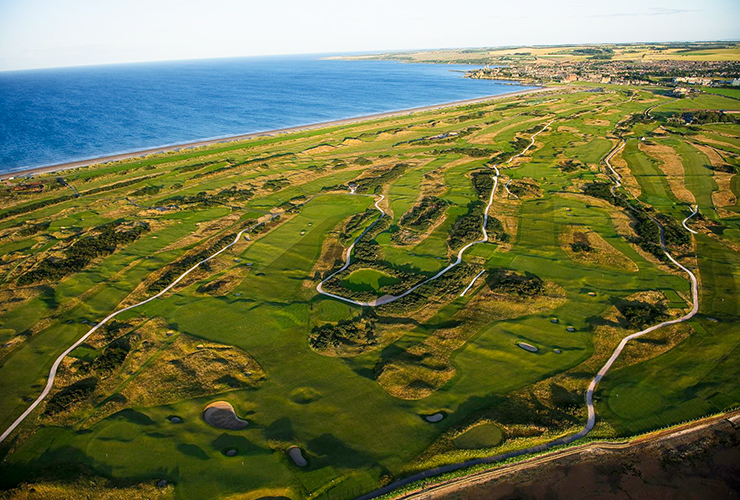His business card reveals to the world that, officially, he is “Executive Director – Governance” at the R&A. But this week, Grant Moir is better described as the “set-up guy.” Over the next few days, the Scot will oversee logistical preparation of the Old Course at St. Andrews, which is hosting the AIG Women’s Open for the third time.
It is a prospect Moir has been anticipating with some relish. The Old Course might just be the most interesting lay-out on the planet when it comes to set-up options. Move the pin as little as 10 feet on some holes and the ideal line/position off the tee can change by as much as 50 yards. So for Moir there is much to think about, much to enjoy.
“It is actually more interesting setting-up the course for a women’s event,” says the 53-year-old Edinburgh University law graduate. “With the men I know I’m going to the back tees on pretty much every hole. With the women, every tee on the course is potentially in play.”
Moir describes his job simply as looking at each hole and figuring out how it will play best for the women. “At the end, we add up the yardages and hope it comes to something reasonably appropriate, which it generally does at the Old Course,” Moir says.
The total yardage for this year, Moir confirmed, will be 6,784 yards, 112 longer than 2013, when Stacy Lewis won the last Women’s Open at the Home of Golf. “But it will only play less than that,” he added. “There may be days when, because of the weather conditions, we will play a number of tees forward. It would be unusual for us to be off the farthest-back tees on all holes on any one day.”

Lorena Ochoa won the title the first time the Old Course hosted the Women’s British Open in 2007 – David Cannon

Stacy Lewis lifts the winner’s trophy following her victory during the final round of the Ricoh Women’s British Open in 2013 – David Cannon
Still, it isn’t the total length of the course that will most influence Moir’s tactics. His initial aim is to bring the features of golf’s most famous course—in this case the myriad bunkers that dot the rumpled landscape—into play for the women in the same way as they are for the men.
“Tee positions are important because we want the bunkers to be a threat,” Moir says. “The reality is that there is a bigger range of hitting distances at a Women’s Open than there is for the men. So achieving that for every player in the field is challenging. What we have found is that we are often using what might be called the old ‘medal tees.’ Sometimes, all you have to do is walk off the green and you are on the next tee. That’s always refreshing and seems to fit well for bringing the bunkers into play. I’m looking forward to seeing the women play the course in the way it was first envisaged.”
There are other set-up differences between the two genders, the most significant being firmness of the greens and the pin positions. The biggest influence on both, of course, is the fact that shots the leading women hit tend not to create as much spin as do their male counterparts.
“Even on a shorter course, the women are more likely to be using longer clubs for their approach shots,” Moir says. “And, if they are using the same clubs as the men, the ball is spinning less. So we don’t have the same emphasis on firmness. That’s not to say the greens won’t be firm this week; they will be. But there is a limit to how firm we would want them to be for the women. Nowadays for the men there isn’t really a limit at all.”
Interestingly, green speed is not something that differentiates the male and female game. For Opens on either side of the gender divide, Moir strives for a Stimpmeter speed of 10½ feet on the Sunday before the event. Then the weather forecast—and invariably the strength of the prevailing wind that comes straight off the Eden Estuary and the steeply sloping 11th green—will determine whether that figure is “gently” adjusted up or down, or stays the same, over the subsequent days.
“If we are at 10½ we have the control we need to go be way or the other,” Moir says. “It’s pretty easy to put speed on. The challenge is taking it off.”
As ever, the subject of pin positions (Moir is careful to say “hole positions” in line with the USGA and R&A’s mystifying wish to meddle with the game’s long-time terminology) is always tricky. It is often the case that Moir doesn’t make a final determination until the night before or even on the morning of play. And this time, differences between the men and the women do play a part in the decision-making process.
“If the weather is good, and the course is playing fast and firm, then clearly the men would be hitting a lot of wedges into the par 4s and reaching the par 5s in two,” Moir says. “That was obvious from the 150th Open in 2022. The hole positions over the four days had to be very demanding just to allow the players to separate themselves from the rest.
“For the women, the hole positions are just as important,” he continues. “But because the course will play ‘longer’ for them, we’re not looking for the 72 hardest positions. We want to be able to utilize more areas of the greens. And not have to be seeking out, necessarily, the four toughest positions on each green. We want the women to be able to showcase their abilities. And the Old Course, unless we have extreme weather, is not somewhere we would expect to see the best players in the world struggling to break par. We want the women to have the ability to score well, in the same way that the men do.”
What has gone the way of the dinosaur is the now out-dated notion that a course set-up for leading professionals should have “six easy, six medium and six hard” pin positions. Indeed, when making presentations to the membership at host courses, Moir likes to joke that the norm these days, at least for the men, is “six hard, six really hard and six brutal.”
“That is just today’s reality,” he says.
Still, there is fun to be had at the Old Course. As is the case for many observers of all things par 5, Moir loves the long 14th, a hole that offers so many options, especially when three shots are required to reach the putting surface. What line a player must take with the second shot in order to leave the easiest third shot varies enormously depending on the pin position.

The par-5 14th hole features the famed “Hell Bunker.” – David Cannon/R&A
The short par-4 12th is another Moir favourite, “an amazing, bizarre and endlessly interesting hole.”
Ah, but then there is the par-5 fifth, which, along with the shared 13th, boasts the biggest double green on the course and so a huge range of pin positions
“It’s a classic,” asserts Moir with a smile. “I’m not sure we will do this, but we have done it for the men. One day we put the hole maybe 12 yards on the green. Then the next day we had it 85 yards from the front.”

The par-4 18th will play more than a long par 3 for the top women’s players this week at the AIG Women’s Open – David Cannon/R&A
For all that, the hole Moir is perhaps most looking forward to watching the women play is the last. In the ever-longer men’s game, the 18th has often been reduced to “long par-3” status. But that won’t be the case for the women. For them, the relationship between the location of a drive, the Valley of Sin that fronts the putting surface and the pin position will provide an eternally fascinating test of first, imagination and second, execution.
“We will be using the same tee as the one we use in the Open,” Moir says. “In the right weather the ball does run a mile, but it is likely we will see the players hitting ‘proper’ wedge shots into the green.”
One last thing. Because of the Olympics, this Women’s Open is being played a couple of weeks later than normal. So even the lengthy gloaming that makes summer golf in Scotland virtually an all-day event is compromised.
“We will be using a two-tee start on the first two days,” says Moir. “That’s just a necessity because we have less daylight to play with.”
True. But they also have a great course, one set-up to its best advantage, to play on.
Main Image: Dom Furore









